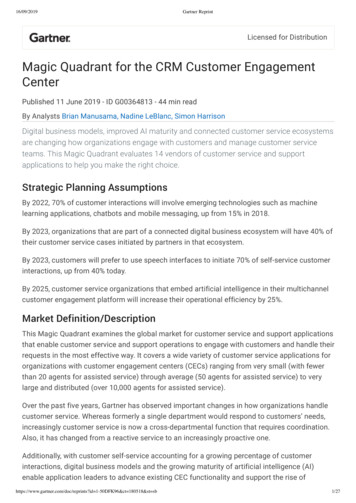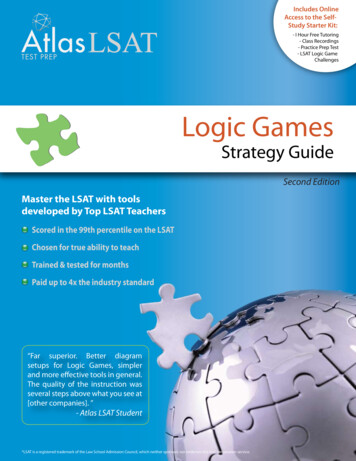
Transcription
16/09/2019Gartner ReprintLicensed for DistributionMagic Quadrant for the CRM Customer EngagementCenterPublished 11 June 2019 - ID G00364813 - 44 min readBy Analysts Brian Manusama, Nadine LeBlanc, Simon HarrisonDigital business models, improved AI maturity and connected customer service ecosystemsare changing how organizations engage with customers and manage customer serviceteams. This Magic Quadrant evaluates 14 vendors of customer service and supportapplications to help you make the right choice.Strategic Planning AssumptionsBy 2022, 70% of customer interactions will involve emerging technologies such as machinelearning applications, chatbots and mobile messaging, up from 15% in 2018.By 2023, organizations that are part of a connected digital business ecosystem will have 40% oftheir customer service cases initiated by partners in that ecosystem.By 2023, customers will prefer to use speech interfaces to initiate 70% of self-service customerinteractions, up from 40% today.By 2025, customer service organizations that embed artificial intelligence in their multichannelcustomer engagement platform will increase their operational efficiency by 25%.Market Definition/DescriptionThis Magic Quadrant examines the global market for customer service and support applicationsthat enable customer service and support operations to engage with customers and handle theirrequests in the most effective way. It covers a wide variety of customer service applications fororganizations with customer engagement centers (CECs) ranging from very small (with fewerthan 20 agents for assisted service) through average (50 agents for assisted service) to verylarge and distributed (over 10,000 agents for assisted service).Over the past five years, Gartner has observed important changes in how organizations handlecustomer service. Whereas formerly a single department would respond to customers’ needs,increasingly customer service is now a cross-departmental function that requires coordination.Also, it has changed from a reactive service to an increasingly proactive one.Additionally, with customer self-service accounting for a growing percentage of customerinteractions, digital business models and the growing maturity of artificial intelligence (AI)enable application leaders to advance existing CEC functionality and support the rise ofhttps://www.gartner.com/doc/reprints?id 1-50DFK96&ct 180518&st sb1/27
16/09/2019Gartner Reprintconnected customer service ecosystems. And as they do so, the very nature and definition ofcustomer service is changing again.Gartner now defines the CRM CEC market as the market for software applications used toprovide customer service and support by engaging intelligently — both proactively and reactively— with customers by answering questions, solving problems and giving advice. Theorchestration of intelligent customer processes through a CEC application is built around a casemanagement record and process. It may include advisory services, problem diagnostics andproblem resolution, account management, insurance claims handling, servicing of bankinginteractions, provisioning and returns management, among other things. To be able toorchestrate the processing of customer engagements for the best outcomes in an effortless,effective and timely way, the workflow is an important component, and some organizationsrequire intelligent business process management (BPM) capabilities. In addition to case andworkflow management, knowledge — and management — of how to enrich and personalizecustomer engagements is crucial.In the previous Magic Quadrant we uncovered the emerging area of “digital customer service.”Vendors in this field often challenge the current vendor landscape, which focuses on casemanagement and systems of record. Digital customer service vendors concentrate on customerengagements that are digital, mobile, customer-initiated and fast. They focus on systems ofengagement, regardless of channel, and they design their platforms for outcome-basedengagements. Although they lack full CEC capability (offering only limited support for casemanagement), and therefore do not qualify for inclusion in this Magic Quadrant, they do managecustomer dialogue and communication for an increasingly large percentage of customerinteraction types. We will recognize such vendors in a forthcoming “Market Guide for DigitalCustomer Service.”Gartner believes that central to the demand for CECs is organizations’ need for a CRMapplication that holds the customer record. But it is also important to recognize that a CECforms part of an organization’s CRM application landscape. This includes other applicationsthat support marketing, sales and digital commerce, with which it must work. A core systemfunction of a CEC is case management (sometimes referred to as “incident management,”“trouble ticketing” or “problem resolution,” depending on the industry context). This requires astrong ability to create, split, federate, join, assign and escalate cases, often in a collaborativeenvironment.We expect that, by 2020, workforce engagement management technology will be an embeddedcomponent of several leading CEC solutions, one intended to help orchestrate processes in linewith employees’ skills, preferences, personalities and performance (for an evaluation of sevencurrent vendors, see “Magic Quadrant for Workforce Engagement Management”).Complementary tools providing guidance, automation and next-best actions, among otherthings, will help optimize operational performance and employee engagement.The best of today’s CEC applications have tools for both agents and customers. For this MagicQuadrant, vendors had to have clear views about how to escalate customer support from digitalhttps://www.gartner.com/doc/reprints?id 1-50DFK96&ct 180518&st sb2/27
16/09/2019Gartner Reprintself-service to human agents (and to de-escalate it again), while retaining interactions’ contextfor the purposes of reporting and improving customer engagements. Additionally, their CECapplications for use by customer service agents must have been designed to operateseamlessly on a common platform by means of common development and integration tools,open APIs and a common graphical user interface. Their applications also had to comply with aset of technical and design considerations that emphasized:1. Scalable cloud-based systems2. Embedded AI within multiple customer service functionalities (such as intelligent casemanagement and intelligent workflows)3. Real-time and predictive analytics4. Agent guidance and navigation5. Proactive messaging to customers6. Automation of engagements using AI7. Digital workflow/BPM support8. Contextual knowledge management9. A participating ecosystem of independent software vendors (ISVs) for functional enrichmentThe software functionality weightings we used for this Magic Quadrant reflect the mostcommon requirements expressed by Gartner clients and our view of how requirements areevolving. In rank order (heaviest weighting to lightest), they are:1. Case management/problem/service resolution (a core CRM system and controls overcustomer master data); also team collaboration capabilities (an evolving requirement)2. A knowledge-based solution with multisource search optimization3. Workflow management4. Real-time guidance/decision support5. Digital engagement channels, including email, chat, messaging, co-browsing and video6. Mobile support7. Predictive customer analytics (sentiment, emotion, intent)8. Adaptive business rule engine9. Social media engagement management10. Support for video libraries and videohttps://www.gartner.com/doc/reprints?id 1-50DFK96&ct 180518&st sb3/27
16/09/2019Gartner Reprint11. Voice of the customer12. Virtual customer assistant13. Internet of Things (IoT) connections (a visionary feature)Magic QuadrantFigure 1. Magic Quadrant for the CRM Customer Engagement CenterSource: Gartner (June 2019)Vendor Strengths and CautionsAppianAppian (https://www.appian.com/) is a publicly traded company focused on low-codeapplication development and intelligent BPM markets. This U.S.-based company provides casehttps://www.gartner.com/doc/reprints?id 1-50DFK96&ct 180518&st sb4/27
16/09/2019Gartner Reprintcentric applications, and it expanded into customer engagement in 2018 with its IntelligentContact Center (ICC) solution.Appian has a global presence and a strong focus on large enterprises and vertical markets suchas financial services, healthcare and U.S. federal government. It has over 1,000 employees,headquarters in Reston, Virginia, U.S., and offices located elsewhere in North America, and inEMEA and Asia/Pacific.In its fiscal 2018, Appian had revenue of 226.7 million, up 28% from a year earlier. Gartnerestimates that the CRM CEC offering represents only a small portion of Appian’s revenue, atapproximately 16 million.With over 30 customers, Appian makes its debut in this Magic Quadrant as a Niche Player. ItsICC solution, built on its low-code platform, addresses the increasing demand for flexible andcustomizable prebuilt solutions.Large organizations, especially in the financial services sector, that are looking for a scalable,heavily case-management-centric CEC solution and that require omnichannel capabilitiesshould consider Appian.Strengths Appian’s CEC offering is built on the same codebase as its low-code BPM platform as aservice (PaaS). It benefits from a highly capable suite of tools for citizen developers for,among other things, case management, workflow and real-time orchestration of hybridprocesses (processes extending to on-premises and cloud environments). The Appian AppMarket offers more than 350 accelerators, tools and extensions built on theplatform by Appian or its partners. Appian recently announced “The Appian Guarantee,” which states that new Appian Cloudcustomers can deploy their first project in just eight weeks and that a technically skilledperson can learn the Appian platform in only two weeks.Cautions Appian does not have a native CEC offering with a software release cycle attached to it. Itprovides a framework with regular updates. Customers are expected to customize thesolution using Appian’s low-code development tools to deploy the solution and they have tolook after the coding themselves. Appian relies on partnerships with Genesys, Google,Temasys and Twilio for additional CEC capabilities. Although Appian scores well for industry-specific capabilities, prospective customers otherthan large enterprises in the financial services, healthcare and government sectors shouldcarefully evaluate its suitability for their specific use cases.https://www.gartner.com/doc/reprints?id 1-50DFK96&ct 180518&st sb5/27
16/09/2019Gartner Reprint Although Appian has strategic partnerships with some major system integrators, Gartnersees a limited number of these partners supporting implementations that rely heavily on theavailability of Appian’s professional services organization.bpm’onlineBpm’online (https://www.bpmonline.com/) is a privately held company with headquarters inBoston, Massachusetts, U.S. Although most customers choose the cloud version of its .NETarchitected application, bpm’online service, this offering is also available on-premises. Givenbpm’online’s history in Europe, most (60%) of its customers come from this region; 15% comefrom the U.S. and 15% from Asia/Pacific. Its customer service and support implementationseach have 67 users on average.Bpm’online service is an intelligent service management, low-code platform, part of a biggersolution for sales, service and marketing. Its main strengths are an attractive and intuitive userinterface, business process modeling capabilities, and an appealing price in comparison withlarge-enterprise CRM systems.Gartner considers bpm’online a Niche Player in this market. Its differentiators are its low-codeplatform and its workflow capabilities.Consider bpm’online if you represent a midsize organization with complex customer serviceprocesses.Strengths Bpm’online’s product is easy to configure and modify, with training. Its scalability and securitystand out, and it received the highest reference customer scores for ease of use of all theproducts from vendors evaluated in this Magic Quadrant. Bpm’online’s product supports both on-premises and cloud-based configurations, whichmeans it offers greater deployment flexibility. Bpm’online offers organizations a low-code BPM platform that confers the agility to changecustomer-facing processes.Cautions In conversations with Gartner about bpm’online, customers of this vendor have expressedconcerns about its training, documentation and project planning. Although bpm’online has many smaller professional service partners worldwide, customersmay have a limited choice of professional services for consulting and integration for largescale and complex projects. Surveyed reference customers for bpm’online indicated that they experienced challenges interms of data migration and of real-time integration with complex environments on a largescale.https://www.gartner.com/doc/reprints?id 1-50DFK96&ct 180518&st sb6/27
16/09/2019Gartner ReprintCRMNEXTCRMNEXT (https://www.crmnext.com/) offers its CEC solution, CRMNEXT ServiceManagement, as part of a complete CRMNEXT platform including customer service, sales,marketing and digital journey capabilities. Its CEC solution can be purchased and implementedwith or without other platform capabilities, according to customers’ needs.Based in India and with new offices in the U.S., CRMNEXT is a division of Acidaes Solutions.Most of its presence (over 90%) is in Asia/Pacific and parts of the Middle East. It has a focuson, and strength in, supporting very large customers. Its top-five clients’ customer supportorganizations each support over 10,000 users. CRMNEXT has direct sales channels in the U.S.,India, Southeast Asia and the Middle East, but relies on partners outside those regions. In theU.S. and Europe, i
Digital business models, improved AI maturity and connected customer service ecosystems are changing how organizations engage with customers and manage customer service teams. This Magic Quadrant evaluates 14 vendors of customer service and support applications to help you make the right choice.











